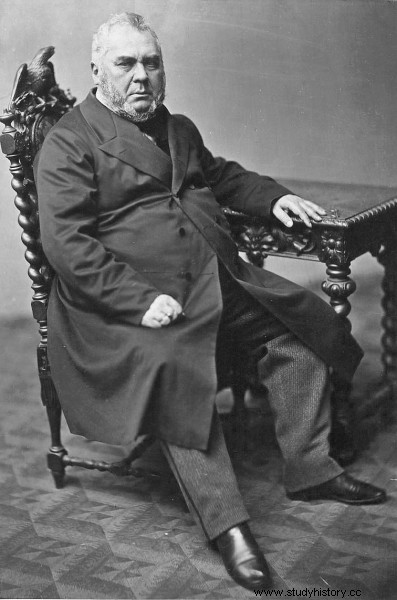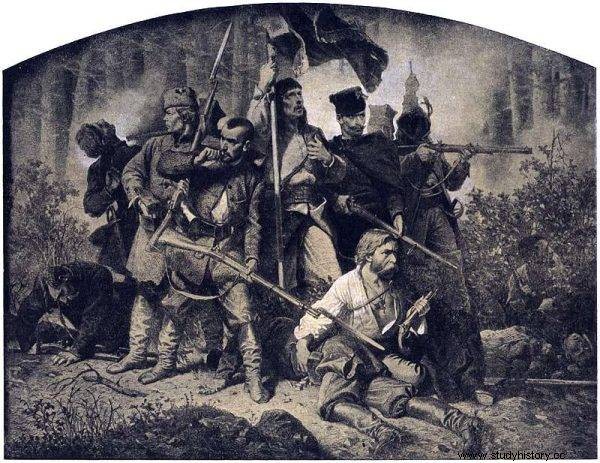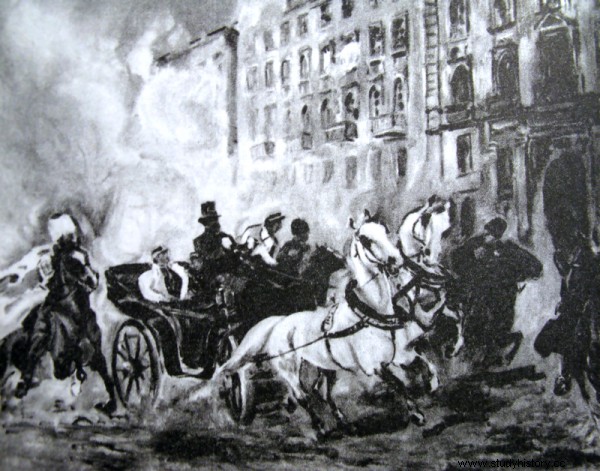They carried death to informers, traitors, tsarist officials and gendarmes. They suddenly appeared in a dark gate, in front of the apartment door. They carried out the sentence on the spot. A few blows with a knife - to the neck, chest and stomach - immediately took the life of the convict. This is how the daggers - the executors of the January Uprising worked.
"On the morning of May 2, they sneaked into the glass gallery, and when Miniszewski was leaving in a bathrobe and naturally without weapons, they fell out of hiding and inflicted three fatal wounds on his neck, heart and breast, so that he would not utter the slightest cry, struck by lightning, crashed to the ground. The daggers left the gallery most calmly and the policeman they met at the gate told him to go upstairs, because somebody felt faint there! " - this is how the murder of Józef Aleksand Miniszewski was described by the Russian historian Nikolai Berg.
Miniszewski, a columnist for Dziennik Powszechny, was stabbed for biting articles criticizing the independence underground and for the support he gave to the head of the government of the Kingdom of Poland, Aleksander Wielopolski. The insurgents considered Wielopolski a traitor.
Daggers - the 5th Division of the Gendarmerie, were the most secretive unit of the underground insurgent police . Therefore, today it is difficult to recreate their fate, methods and scale of operation. They did not keep any registers, they did not leave any personal files or documentation. Those who were captured by the tsarist services took their secrets to the graves. Prof. Jarosław Kita from the University of Łódź comments:
It is necessary to emphasize the great courage and determination of young people joining the formation of daggers and hanging gendarmes. If they were captured by the Russians, they could not count on pardon. Most often they were sentenced to death, hence they constitute a significant percentage of all insurgents executed on the scaffolds.
Skrytocidal Warsaw
Terrorism and assassination were an attempt to react to the increasing harassment and crimes of tsarism. In 1861, there was a series of bloody pacifications of patriotic demonstrations in Warsaw. On February 25, 1861 (on the anniversary of the battle for Olszynka Grochowska during the November Uprising), the Russian army opened fire on the demonstrators, 5 participants died.
On April 8, 1861, over 1,000 tsarist soldiers pacified the demonstration at Castle Square . The army was firing at the defenseless crowd. The estimated number of victims is at least 100. In fact, it could have been much bigger. After the massacre, the Russian authorities tried to keep the actual scale of the massacre so as not to cause panic. The demonstration in Vilnius in August 1861 was similarly bloodily pacified.

One of the would-be victims of the daggers was the head of the Civil Government, Aleksander Wielopolski.
On October 14, 1861, Karol Lambert, the Russian governor of the Kingdom of Poland, imposed martial law. A day later, the army suppressed another demonstration - on the anniversary of Tadeusz Kościuszko's death. However, harassment and massacres only aggravated the situation. In October 1861, Ignacy Chmieleński, the son of the tsarist general, who, however, did not follow in his father's footsteps, founded the underground City Committee in Warsaw, which dealt with the preparation of the uprising, including the recruitment of people willing to give their lives for the cause. It was he who brought the daggers to life.
The conspirators also tried to win over anti-tsarist Russians - also in the army. A secret society of Polish officers in the tsarist army was established in St. Petersburg, a similar association - uniting the Russians plotting against the Tsar - was established in Warsaw. Its founder was a Ukrainian, Andrei Potebnia, who later participated in the January Uprising.
On June 27, 1862, Potebnia came to the Saski Garden. He stood behind the tsarist governor Alexander Nikolaevich von Lüders walking along the park alley. He drew his gun and, in front of the gathered guests, tried it on and fired. The governor has fallen. Blood began to drip from his mouth . After firing a shot, in the chaos that had broken out, he left the scene of the crime as if nothing had happened.
Lüders survived. The bullet hit the neck, pierced the mouth and, injuring the tongue, came out through the mouth. However, he was unable to continue his mission. He was replaced by Prince Konstanty - brother of Tsar Alexander II himself. Just after a few days in Warsaw, a 22-year-old apprentice tailor Ludwik Jaroszyński shot the prince in front of the door of the Grand Theater. The target of the attack was lucky - the bomber missed. He was caught on the spot and sentenced to death.
On August 7, 1862, near the Treasury Commission at Bankowy Square, the assassins tried to murder Aleksander Wielopolski, who was especially hated by the underground, the then head of the civil government of the Kingdom of Poland, who was considered a traitor and, together with the Russians, blamed for the massacres in the capital. Wielopolski was the author of the "law on gatherings", which allowed the use of armed force against civilians. The Russian army eagerly used this possibility, pacifying the demonstrations bloodily.
At Bankowy Square, the count was lucky. He survived the coup. 20-year-old Ludwik Ryll was captured on the spot. A few days later, his partner, 19-year-old Jan Rzońca, "burst in" and tried to murder him again from the hated Wielopolskie. When the carriage was going through Aleje Ujazdowskie, he jumped on the step with a knife in his hand. He was trying to deliver the killing blow. Without success. The count leaned back. Russian historian Nikolai Berg later argued that the knife was very sharp and covered with strychnine. "One gram of this mass, given to two-month-old puppies, resulted in immediate death" - he wrote about the result of the expert opinion.
The bombers were to die so that it would be a lesson for others. Jaroszyński, Rzońca and Ryll were executed on the slopes of the Warsaw Citadel. The effect was counterproductive. Assassins have risen to the rank of heroes. An anonymous poem circulated in Warsaw titled Hello hangers:
Poland is not wasted yet, / When on one day she released / Such an abundant harvest. / Three Youths - Children of the Commonwealth / Stunned by the action flower, / Ready to finish
Their hut was their cradle, / A silent witness of the casemate / Their last moments. / And on the bloody shield of the sun / Three names are flashing:/ Rzońca Jaroszyński, Ryll… / Bravely boys went on the enemy / Hello hangmen, hello!
Knives of Justice
In 1862, the National Permanent Committee was associated, which transformed into an insurgent government. The underground structures also had a gendarmerie, and within it a secret unit of daggers. "Daggers and hanging gendarmes carried out death sentences on officials of the partitioning power system, spies and traitors , tsarist agents and provocateurs, but at the same time they were the executors of sentences against members of the insurgent organization, even commanders of insurgent parties who had committed crimes or offenses, ”explains Prof. Jarosław Kita.

The daggers were the most conspiratorial group in the underground insurgent police.
It is estimated that about 1,000 daggers could be active in the entire Kingdom of Poland. There were 200 of them in Warsaw alone. The next high-profile assassinations were picked up by the Warsaw street. The murder of the journalist Józef Aleksand Miniszewski echoed. Major Wasyl von Rothkircht, deputy director of the Special Chancellery for Martial Law, was also killed in the attack. He was also stabbed to death, among others Russian spy Berthold Hermani and another tsarist officer, a Pole with Tatar roots - Aleksander Mirza Tuhan-Baranowski. Daggers stabbed him in his own home, despite the tsarist protection.
The number of deaths by executors in Warsaw is estimated at 24, and the same number was wounded. However, according to Nikołaj Berg, as many as 1,000 people died at the hands of Polish assassins. The psychological effect of intimidating the enemy was achieved not only with high-profile murders. Carscy officials and policemen received anonymous threatening letters. Apparently, the conspirators' imagination in this regard was considerable. For example, Berg claimed that General Yevgeny Roznov, assistant to governor Konstantin, had received a letter of… human remains. "Once he was sent a bag containing the finely chopped bones of one of his agents," recalled the Russian historian. Prof. Kita comments:
The actions of the daggers were as intended. They aroused, if not fear among the Russians and the Poles and Jews who collaborated with them, then they certainly were uncertainty and the fear of endangering their lives. Maybe this way there were fewer traitors and tsarist henchmen?
Chopin's piano
On September 19, 1863, a series of explosions shook the New World in Warsaw. The carriages of the tsarist governor, General Fyodor Berg, were driving with Cossacks past tenement house No. 67, when several bombs dropped by the attackers from the windows of the building exploded one after another. The injured horses started to gallop. The carriage was riddled with holes. The adjutant of the governor was mortally wounded, but Berg himself was not hurt.
After the unsuccessful attempt, the occupier applied collective responsibility. The inhabitants of the tenement house in Nowy Świat (the so-called Zamojski Palace) were evicted from their homes. The tsar soldiers were making boiling water in the apartments. The property of the tenants was flying from the windows onto the street. The most valuable things were stolen. The virtuoso piano was thrown from the apartment of Fryderyk Chopin's sister, Izabela Barcińska. The instrument shattered against the pavement. This gloomy picture inspired a poem by Cyprian Kamil Norwid. The owner of the building - Prince Stanisław Antoni Zamoyski - was sentenced to 8 years of hard labor. The tsar soldiers then burned all their belongings, which had not been stolen.

Unsuccessful attempt to assassinate Fyodor Berg organized by insurgents in 1863.
The governor, who survived the attempt on his life, imposed a contribution on Warsaw. Even the administrators of the houses where the insurgents were hiding were punished. In April 1864, the last dictator of the January Uprising, Romuald Traugutt, was arrested. It was placed in the 10th Pavilion of the Warsaw Citadel. He did not release anyone during the interrogations. Sentenced to death, he was hanged in the vicinity of the fortress. Less than a year later, the same fate befell the last dagger commander, Emanuel Szafarczyk. It was issued by a friend who was bribed with a concession to run a tavern. On February 17, 1865, the sentence was carried out.
Thus, the activities of the assassins of the January Uprising ended. Their traditions and methods of operation were, however, referred to by other conspirators, including from the PPS Combat Organization, headed by Piłsudski in the "revolutionary" period of his activity and 40 years later the founders of the Polish Underground State. It was the January insurgents, including the daggers, who were the role models for the Home Army and its enforcement units. According to prof. Jarosław Kita:
Historians don't mention daggers very often. On the one hand, this is the result of a fairly slim source base about them, which is a consequence of the nature of their struggle and very far-reaching conspiracy. But on the other hand, it seems to me that the nature of their business also influences this state of knowledge.
Terrorism and assassination are not viewed positively in the modern world. Thus, the dagger does not fit the ethos of an insurgent-national hero who fought against the hated enemy in one of hundreds of skirmishes and battles. However, if armed struggle is undertaken in such a disadvantageous political and military situation as during the January Uprising, I believe that any form of activity leading to the realization of the national cause should be accepted.
Bibliography:
- Nikołaj Wasiljewicz Berg, Notes on Polish conspiracies and uprisings . Th. 1, Warsaw 1906.
- Stefan Kieniewicz, Conspirators and partisans of 1863 . Warsaw:Wyd. Ministry of National Defense 1967.
- Wojciech Lada, Polish terrorists , Horizon 2018 sign.
- Mikołaj Pawliszczew, Weeks of the Polish rebellion . Vol. II and II. Warsaw:Bellona 2003.
- Franciszka Ramotowska, The secret Polish state in the January Uprising 1863-1864:Organizational structure , Warsaw 1999–2000.
- Jarosław Szarek, The January Uprising:Rush of free Poles . Krakow:AA Publishing House 2013.
- Jarosław Tomasiewicz, Terrorism on the background of political violence (Outline encyclopedic) , Katowice 2000.
